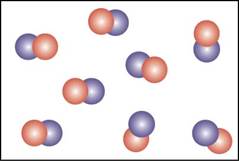
Concept explainers
Interpretation: The class of pure substances and the physical state of these substances from the given figures are to be identified.
Concept introduction: The pure substances that are made up of only one type of atom are called elements. Elements do not break down in simpler substances.
The pure substances that are composed of atoms from more than one element held together by
To determine: The class of pure substances and the physical state of these substances from the given figures.
Answer to Problem 1.1VP
The pure substances given in Figure
There are two types of balls given in Figure
Explanation of Solution
The first pure substances are given in Figure

Figure
The pure substances given in Figure
The compounds given in Figure
The second pure substances are given in Figure

Figure
There are two types of balls given in Figure
The red balls given in Figure
The blue balls given in Figure
The pure substances given in Figure
There are two types of balls given in Figure
Want to see more full solutions like this?
Chapter 1 Solutions
Chemistry Smartwork Access Code Fourth Edition
- Q1: Draw a valid Lewis structures for the following molecules. Include appropriate charges and lone pair electrons. If there is more than one Lewis structure available, draw the best structure. NH3 Sulfate Boron tetrahydride. C3H8 (linear isomer) OCN NO3 CH3CN SO2Cl2 CH3OH2*arrow_forwardIn the following molecule, indicate the hybridization and shape of the indicated atoms. -z: CH3 CH3 H3C HO: CI: :arrow_forwardQ3: Draw the Lewis structures for nitromethane (CH3NO2) and methyl nitrite (CH3ONO). Draw at least two resonance forms for each. Determine which form for each is the major resonance contributor. Page 1 of 4 Chem 0310 Organic Chemistry 1 Recitations Q4: Draw the Lewis structures for the cyanate ion (OCN) and the fulminate ion (CNO-). Draw all possible resonance structures for each. Determine which form for each is the major resonance contributor.arrow_forward
- Indicate what metal clusters are.arrow_forward55. The photoelectric threshold energy for ytterbium metal is 4.16 × 10-19 J/atom. a. Calculate the wavelength of light that this energy corresponds to (in nm). b. Which region of the electromagnetic spectrum does this wavelength fall in? c. Would light of wavelength 490 nm produce a photoelectric effect in ytterbium? Why or why not?arrow_forward14.50 Explain why methyl vinyl ether (CH2=CHOCH 3) is not a reactive dienophile in the Diels-Alder reaction.arrow_forward
- Show work with explanation needed. don't give Ai generated solutionarrow_forward14.49 From what you have learned about the reaction of conjugated dienes in Section 14.10, predict the products of each of the following electrophilic additions. a. H₂O H2SO4 Br2 b. H₂Oarrow_forward14.46 Draw a stepwise mechanism for the following reaction. HBr ROOR Br + Brarrow_forward
 ChemistryChemistryISBN:9781305957404Author:Steven S. Zumdahl, Susan A. Zumdahl, Donald J. DeCostePublisher:Cengage Learning
ChemistryChemistryISBN:9781305957404Author:Steven S. Zumdahl, Susan A. Zumdahl, Donald J. DeCostePublisher:Cengage Learning ChemistryChemistryISBN:9781259911156Author:Raymond Chang Dr., Jason Overby ProfessorPublisher:McGraw-Hill Education
ChemistryChemistryISBN:9781259911156Author:Raymond Chang Dr., Jason Overby ProfessorPublisher:McGraw-Hill Education Principles of Instrumental AnalysisChemistryISBN:9781305577213Author:Douglas A. Skoog, F. James Holler, Stanley R. CrouchPublisher:Cengage Learning
Principles of Instrumental AnalysisChemistryISBN:9781305577213Author:Douglas A. Skoog, F. James Holler, Stanley R. CrouchPublisher:Cengage Learning Organic ChemistryChemistryISBN:9780078021558Author:Janice Gorzynski Smith Dr.Publisher:McGraw-Hill Education
Organic ChemistryChemistryISBN:9780078021558Author:Janice Gorzynski Smith Dr.Publisher:McGraw-Hill Education Chemistry: Principles and ReactionsChemistryISBN:9781305079373Author:William L. Masterton, Cecile N. HurleyPublisher:Cengage Learning
Chemistry: Principles and ReactionsChemistryISBN:9781305079373Author:William L. Masterton, Cecile N. HurleyPublisher:Cengage Learning Elementary Principles of Chemical Processes, Bind...ChemistryISBN:9781118431221Author:Richard M. Felder, Ronald W. Rousseau, Lisa G. BullardPublisher:WILEY
Elementary Principles of Chemical Processes, Bind...ChemistryISBN:9781118431221Author:Richard M. Felder, Ronald W. Rousseau, Lisa G. BullardPublisher:WILEY





